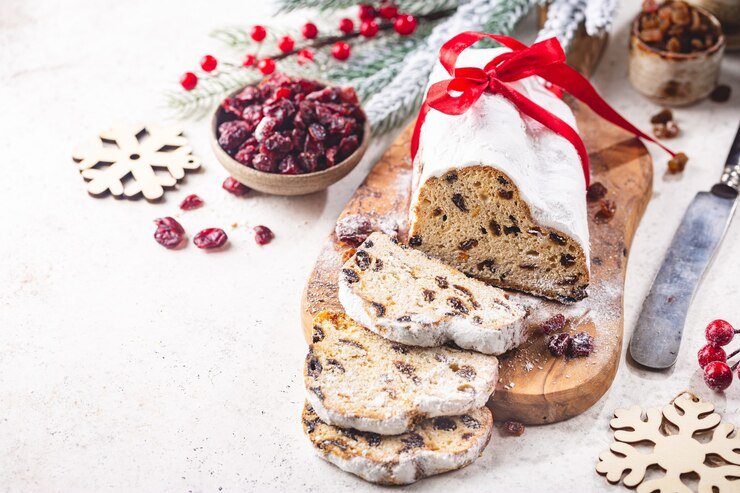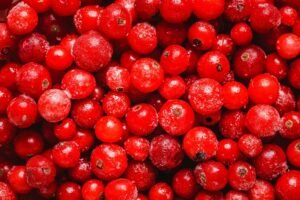What causes cranberry bread to crumble? Exploring the Key Factors
What causes cranberry bread to crumble?Cranberry bread is a delightful treat that combines the tartness of cranberries with the soft, sweet texture of bread. It’s particularly popular during the fall and winter months and can vary from rustic loaves to cake-like versions, often enhanced with orange zest, nuts, or spices.
Brief History and Popularity
Originating in North America, cranberry bread was influenced by early settlers learning about cranberries from Native Americans. It evolved from a basic necessity to a festive favorite, especially in the United States and Canada, as sugar became more accessible.
Common Uses and Variations
Versatile in use, cranberry bread is a staple at holiday gatherings, a popular gift during festive seasons, and a comforting addition to breakfast or brunch. Recipes often vary by adding nuts like walnuts or pecans, or using whole wheat flour or oatmeal for a nutritious twist.
Understanding the Basics of Baking Cranberry Bread
Ingredients Commonly Used
Flour: The base of the bread, providing structure. All-purpose flour is most common, but some bakers use whole wheat for a denser, healthier loaf.
Sugar: Adds sweetness to counteract the tartness of the cranberries. White sugar is typical, though some prefer brown sugar for a deeper flavor.
Baking Powder: A leavening agent that helps the bread rise. Some recipes may also use baking soda, especially if there’s an acidic component like buttermilk.
Salt: Enhances the flavors of the other ingredients.
Eggs: Bind the ingredients together and add moisture and richness.
Fat (Butter or Oil): Adds moisture and flavor. Butter gives a richer taste, while oil makes for a moister loaf.
Milk or Buttermilk: Provides the liquid needed for the batter and contributes to the bread’s texture and flavor.
Cranberries: The star ingredient, adding tartness and moisture. Both fresh and dried cranberries are used, depending on the recipe.
Optional Add-ins: Nuts, orange zest, or spices like cinnamon and nutmeg can be included to add complexity and flavor.
Typical Baking Process
- Preheat Oven: Start by preheating your oven, usually to around 350°F (175°C), ensuring it’s at the right temperature before the bread goes in.
- Prepare Ingredients: Measure out all ingredients. Chop cranberries if using fresh and prepare any additional add-ins like nuts or zest.
- Mix Dry Ingredients: In one bowl, whisk together the flour, sugar, baking powder, and salt.
- Mix Wet Ingredients: In another bowl, beat the eggs with melted butter (or oil) and milk or buttermilk.
- Combine Wet and Dry Ingredients: Add the wet ingredients to the dry ingredients and stir until just combined, being careful not to overmix to avoid a tough texture.
- Fold in Cranberries and Add-ins: Gently fold in the cranberries and any other add-ins like nuts or zest.
- Bake: Pour the batter into a greased loaf pan and bake for about 50-60 minutes, or until a toothpick inserted into the center comes out clean.
- Cool: Allow the bread to cool in the pan for a few minutes before transferring it to a wire rack to cool completely. This helps in handling and slicing.
This step-by-step process ensures a deliciously moist and flavorful cranberry bread, perfect for any occasion.
Factors Contributing to Crumbling
Moisture Content
- How Moisture Affects the Structure: Moisture is crucial in determining the texture of cranberry bread. Too much moisture can make the bread soggy and undercooked, while too little can lead to dryness and crumbling. The presence of cranberries, which contain natural juices, can alter the moisture balance, necessitating adjustments in the amount of liquid ingredients to achieve the right texture.
Ingredient Ratios and Mixing Techniques
- Importance of Accuracy in Ingredient Measurements: Precise measurement of ingredients is fundamental to baking success. An imbalance, such as too much flour or not enough fat, can make the bread crumbly. Each ingredient plays a specific role, and their correct proportions ensure a cohesive mix that bakes into a moist, well-formed loaf.
- Effects of Over-Mixing or Under-Mixing: Mixing affects gluten development in the flour. Over-mixing can lead to too much gluten, making the bread tough and dense, which paradoxically can also make it more prone to crumble when sliced. Under-mixing might not integrate the ingredients thoroughly, leading to uneven texture and crumbly spots where the ingredients didn’t combine properly.
Baking Time and Temperature
- How They Impact the Texture of the Bread: The right baking time and temperature are critical for setting the structure of the bread. If the bread is baked at too high a temperature, the outside can become overcooked before the middle has set, leading to a crumbly texture. Conversely, too low a temperature can result in a dense, undercooked loaf that crumbles under the knife. Typically, cranberry bread is baked at a moderate temperature (around 350°F) for about 50-60 minutes, though adjustments may be needed based on the oven and specific recipe nuances.
In summary, controlling moisture, adhering to precise ingredient ratios, using proper mixing techniques, and regulating baking time and temperature are all vital in preventing cranberry bread from crumbling. These factors work together to create a delicious loaf with a perfect balance of firmness and tenderness.
Specific Issues with Cranberry and Nut Breads
Role of Fruits and Nuts in Baking
- How Cranberries and Nuts Can Alter the Bread’s Texture: Fruits like cranberries and nuts are popular add-ins in baking due to their flavor and textural contributions. However, they also bring challenges, particularly in how they interact with the bread’s structure. Cranberries, whether fresh or dried, add moisture and acidity, which can affect how the gluten develops during baking. Nuts introduce fat and can disrupt the gluten matrix, leading to potential weak spots in the bread where it might crumble or break.
Distribution and Size of Add-Ins
-
Managing Size and Spread of Cranberries and Nuts
- Size and Distribution Effects: Large chunks of nuts or fruit create uneven moisture or fat pockets. This impacts how the bread cooks and holds together. Chopping cranberries and nuts to uniform size helps even distribution and structural integrity.
- Preventing Sinking of Add-Ins: To avoid sinking and uneven baking, coat cranberries and nuts in flour before mixing. This technique keeps them suspended and evenly distributed in the batter.
- Moisture Content Adjustments: The moisture content of the batter may need adjustment when adding cranberries. Increase or decrease liquid based on whether you use fresh or dried cranberries to balance the moisture they add or absorb.
Understanding and managing these factors helps prevent crumbling and achieves a balanced, cohesive loaf. Each slice looks as good as it tastes.
Practical Tips to Prevent Crumbling
Preparation of Ingredients
- Tips for Chopping Nuts and Preparing Cranberries: Chop nuts into small, even pieces using a sharp knife. This uniformity helps distribute them well in the batter, reducing weak spots in the bread. Wash fresh cranberries and dry them thoroughly to avoid excess moisture in the batter. For dried cranberries that are too dry, rehydrate them in warm water before adding to the dough.
Slicing Techniques
- How to Slice Bread Properly to Minimize Crumbling: Using the right techniques is key to preserving the bread’s structure.
- Use the Right Knife: A sharp, serrated bread knife is best. It cuts through the crust and soft interior without crushing the bread, maintaining slice integrity.
- Let the Bread Cool Completely: Allow the bread to cool before slicing. Cooling helps the starches set and the moisture stabilize, keeping slices intact.
- Proper Slicing Technique: Employ a gentle sawing motion with minimal pressure. Start with the crust and continue with even, light strokes. Avoid pressing down hard to prevent crushing and crumbling.
- Thickness of Slices: Choose thicker slices for stability, especially with nut and cranberry add-ins.
These preparation and slicing steps greatly reduce the chance of your cranberry bread crumbling, ensuring perfect slices for serving.
Advanced Baking Tips
Alternative Ingredients and Their Effects
-
Substitutes for Common Ingredients and Their Impact on Texture
- Experimenting with Alternative Ingredients: Changing common ingredients can transform the texture and flavor of cranberry bread.
- Flour Substitutes: Using gluten-free flour blends or almond flour can meet dietary needs but might change the bread’s structure. These flours often lead to a crumblier texture, so consider adding xanthan gum or more eggs to improve binding.
- Sweetener Options: Replacing white sugar with coconut sugar or honey influences moisture and flavor. These alternatives can enhance the bread’s taste and affect its density and moisture retention.
Adjusting these ingredients requires careful consideration to balance texture and flavor, ensuring a delicious and accommodating cranberry bread.
- Experimenting with Alternative Ingredients: Changing common ingredients can transform the texture and flavor of cranberry bread.
Technological Advancements in Baking
- How Modern Tools and Techniques Can Help: Advances in baking technology and kitchen equipment have made it easier to achieve consistent results and experiment with complex recipes:
- Precision Baking Tools: Digital scales allow for more precise measurements of ingredients, which is crucial in baking. This accuracy helps ensure the balance of dry and wet ingredients, reducing the likelihood of a crumbly texture.
- High-performance Ovens: Modern ovens with even heating and accurate temperature controls eliminate many of the variables that can lead to baking failures. Features like convection settings can help achieve a more even crust, which supports the bread’s structure and prevents sinking or excessive crumbliness.
- Silicone Baking Molds and Pans: These non-stick, flexible molds make it easier to remove the bread from the pan without tearing, reducing the risk of crumbling when turning out the loaf. Their heat-resistant properties also distribute heat more evenly, which can improve the overall texture of the cranberry bread.
By leveraging these advanced baking tips and incorporating modern tools and techniques, bakers can enhance their cranberry bread recipes, achieving delightful results with fewer structural issues. These innovations not only simplify the baking process but also open up new possibilities for creative and health-conscious adaptations.
FAQs
Why does my quick bread crumble when I cut it?
Quick breads, including cranberry bread, can crumble when cut due to several factors such as underbaking, excessive flour, or insufficient binding agents like eggs and fat. Ensuring that the bread is fully baked is crucial; a toothpick inserted into the center should come out clean. Additionally, accurate measurement of ingredients helps maintain the correct moisture and binding ratios, which are essential for structural integrity.
What makes homemade bread crumbly?
Homemade bread can become crumbly due to a variety of reasons, including incorrect flour types, imbalanced ingredient ratios, or inadequate mixing techniques. Using too much flour or not enough binding ingredients (like eggs or oil) can disrupt the gluten network, leading to a crumbly texture. Properly measuring ingredients and following the mixing instructions closely can help create a more cohesive and moist loaf.
How do you make cranberry bread less dense?
To make cranberry bread less dense, consider adjusting the leavening agents and mixing method. Using a combination of baking soda and baking powder can help the bread rise better, especially if acidic ingredients like buttermilk or yogurt are involved. Additionally, ensuring not to overmix the batter is key; mix just until the dry and wet ingredients are combined. This prevents overdevelopment of gluten, which can make the bread heavy and dense.
Recommended Internal Links
- « Best Bread Machine Bread » – In the section where you discuss the preparation of the cranberry bread dough, you can add a link with the phrase « bread machine » to offer readers an alternative method using a bread machine. This could help readers who prefer using a bread machine for baking.
- « Cranberry Nut Bread » – When you mention the ingredients or variations of cranberry bread, such as nuts, link the phrase « Cranberry Nut Bread » to provide readers with another recipe variation that includes nuts.
- URL: Cranberry Nut Bread
- « Quick and Easy Brownies » – In a section discussing desserts or complementary dishes, you might suggest « other quick and easy recipes » and link to the brownies recipe as an example of another simple dessert option.
External Links and Recommended Anchor Text
- King Arthur Baking – Tips for Perfect Quick Breads – « advanced baking techniques for quick breads »
- Food Network – Best Practices for Baking with Dried Fruit – « utilizing dried fruits in baking »
- Serious Eats – The Science of Baking – « understanding the science behind baking »
This FAQ section, enriched with targeted keywords and expert links, rounds out the comprehensive guide on baking the perfect cranberry bread, addressing common issues and questions to enhance the reader’s baking experience.
Understanding What Causes Cranberry Bread to Crumble
In our journey through baking cranberry bread, we’ve explored key factors that impact its texture and structure. We’ve delved into the importance of ingredients and how they interact, along with mastering the art of slicing.
We provided tips for selecting and preparing add-ins like nuts and cranberries and discussed advanced baking techniques. These insights empower bakers of all levels to perfect their loaves.
Furthermore, we incorporated internal links to related recipes and baking tips, enhancing the resource for both new and experienced bakers.
This article not only guides you in making perfect cranberry bread but also celebrates the joys and challenges of baking. As you experiment with recipes and refine your techniques, remember: each loaf represents a story of creativity and dedication in the kitchen. Baking brings both flavor and warmth to your table, whether for everyday meals or special occasions.



